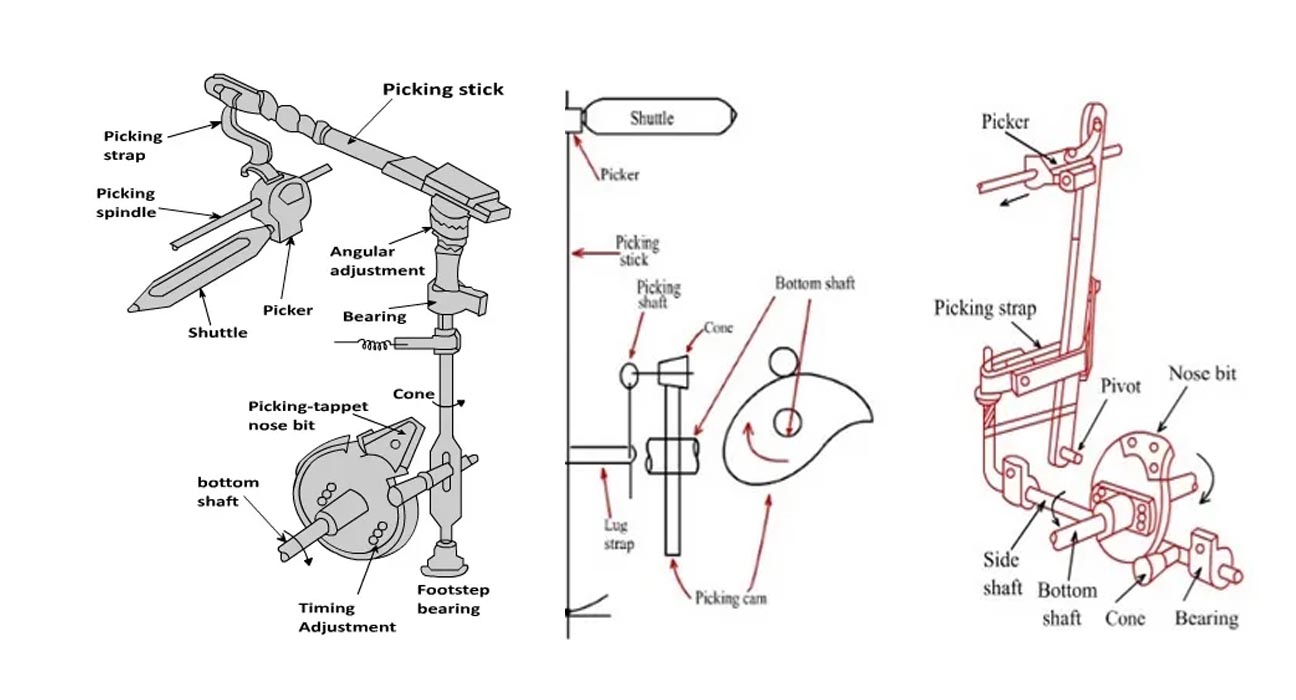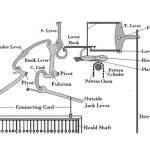Experiment Name: Study on Picking Mechanism.
Introduction:
Pick is a single weft thread in a woven fabric. Picking is the second primary motion in weaving. The action of inserting weft yarn through the warp yarns is called picking. Picking motion propels the weft from one end of the loom to the other. It may be done by hand or by using devices like a shuttle, gripper, rapier, air jet, or water jet. Picking may be carried out with or without a shuttle.
If the picking is done due to the picking arrangement being situated upon the shuttle box, then it is called over pick / over picking.
On the other hand, If the picking is done due to the picking arrangement being situated under the shuttle box, then it is called under pick / under picking.
Study on Picking Mechanism
Objectives:
- Learn about the picking mechanism of the tappet loom.
- Know about different parts related to this mechanism.
- Learn the construction of under and over picking.
- Get an idea about the working procedure of the picking mechanism.
Over Picking Mechanism
Features of Over Picking Mechanism:
- Picking arm is over shuttle.
- Suitable for narrow loom.
- Higher picks per minute.
- Less power required.
- Works more smoothly.
- Shortening the picking strap and changing the shape of the cam can increase picking force.
Main Parts:
- Picking arm
- Picking strap
- Picker
- Bottom shaft
- Picking spindle
- Shuttle
- Picking cam
- Vertical shaft
- Cone
- Bowl
- Angular
- Crank shaft
Figure
Working principle of Over picking mechanism:
- With the rotation of loom/bottom shaft, picking tappet or cam rotates.
- In revolving, picking tappet nose strikes the cone shaped antifriction roller on the stud and partly rotates the picking shaft and the picking lever/stitch.
- The picking arm/lever moves from right side to left side of the loom. It will give angular movement which causes the picker to move inward with sufficient velocity to drive the shuttle across the loom.
- When the picker strikes the shuttle, the shuttle moves into the open shed through race board.
- Picking is done.
- The spring causes the picking arm and picker to move back after the delivery of a pick.
How to Increase PPM/picking per minute:
- By increasing motor speed.
- By setting the cone stud nearer to the picking tappet.
- By decreasing the picking strap.
- By altering the position of picking arm towards the center of the loom.
- By decreasing the length of the stroke of picking tappet.
Under picking mechanism
Main Features of under-picking mechanism:
✔Picker arm is placed under the race board.
✔Suitable for wider loom.
✔Under picking works less smoothly.
✔More direct action.
✔Rough in action.
✔More clean mechanism.
✔Consumes more power.
✔Used for heavy weight fabrics in silk and rayon looms.
Main Parts:
✔Picking arm ✔ Picker ✔Picking cam ✔Picking bowl ✔Race board ✔Shuttle
✔ Bottom shaft ✔Treadle lever ✔ Angular lever ✔ Crank shaft
Figure
Working principle of under picking mechanism:
✔The tappet is driven by the bottom shaft. When the picking tappet strikes the picking
cone, it displaced and the side shaft is Turned.
✔The turning action of side shaft pulls the picking stick which is connected to side shaft
by picking strap. The lower end of picking stick is pivoted. So that is pulled with the
pulling of side Shaft.
✔Then the picker connected to picking arm strikes the shuttle and causes it to pass
through the warp shed. Picking is done.
Picking faults:
- Early picking
- Late picking
- Smash/Banging-off
- Short picking
- Harsh picking
- Shuttle flying picking
Conclusion:
The over picking mechanism is very essential. The over picking motion is negative one; the exact amount of power is required to drive a shuttle. By this experiment students will be able to learn practically that how works the over picking mechanism.
Read: Study on Pirn Winding Machine |Lab Report|





